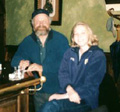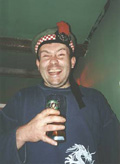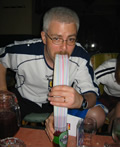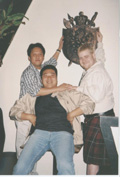| How would you like to view this page? | ||
|
Jump to:
See Also: |
IMPORTANT: If you are easily offended, please do not read on without first reading the Special Disclaimer. This article is purely an attempt at humour and is not intended to cause any offence. |
||||
Latvian beer is surprisingly palatable, and Aldaris is widely available. Look out for the Lido brand too, as they have a few more unusual concoctions available. Voddy is the other big shifter in these parts, and top notch it is too. Amongst a whole host of brands, Stolichnaya is available, and is one of Helen’s favourites (her being a voddy connoisseur and that!). Rigas Black Balsam is the local spirit, and is not dissimilar from Estonian Vana Tallinn – tasting like cough medicine on it’s own, Black Balsam is far better in a cocktail with ice cream. Latvia can also boast the most northerly vineyards in the world, and even manage to knock out a decent champagne. Latvia’s ethnically divided population (Latvian and Russian) does add a certain edge to nights out, with the Russian locals seeming to prefer vodka oblivion to the beer-fuelled sessions of the Latvians (however, both are interchangeable). Despite the same easy availability of top-notch bevvy at low Baltic prices as it’s neighbours, Latvia does not stand out particularly for drunken disorderly-ness.
|
|
||||
Much like the rest of north-east Europe, Lithuania is a vodka-friendly country. Beer is particularly palatable, ranging from the widely available Utenos to the home-brewed Avilys (brew pub in Kaunas and Vilnius). The Avilys honey beer is one of the world’s greatest, and the Ginseng beer is interesting, to say the least. As well as voddy, the local firewater of choice is Mead (or “Midus”) – think Drambuie without the whisky tang. Mead comes in a variety of strengths, ranging from a healthy 12% up to a silly 75%. My first experiences were with the 50% flavour, and it proved to be a very cheap night, however my most recent encounter was a double shot of the 75% version (Zalgiris brand). A gift from an ageing, grinning skinhead in a backstreet rockers pub called Bis, the tipple was served flaming on a platter with an attached bicycle bell, which was being rung enthusiastically by the barmaid. I managed half before my straw melted (the flames had been licking my lips up to this point). I didn’t need the second half. Lithuanians are often called the Italians of the Baltics. Not for their (alleged!) snobbishness and desire to parade around like peacocks, but more for their passionate outlook and reputation for rash decisions. This lends a certain unpredictability to drinking in the country, and creates a fertile breeding ground for any mental jakies. The backstreets of Vilnius proved a happy hunting ground, with quite a few “characters”, whilst the PUB is another honeypot. Personally, we found the drunkest revellers at rocker pub Bis (although that could have just been me, post-mead), and the lively Brodvejus.
|
|
||||
Moldova Moldova's previous status as the vineyard of the Soviet Union has left the locals with easy access to top notch wine at low prices. Local beer (Bere Chisinau and Vitanta) is easily available, although often several months out of date - of course this may improve the alcohol content, which may explain some of the locals behaviour. The real choice of the discerning jakey is either vodka in quadruple measures (100 ml!), a hangover from Soviet days, or local Ialoveni sherry - a bit on the salty side, but best sampled in the basement of the factory shop on Chisinau's main street.
|
|
||||
Beer is expensive in Norway. VERY expensive. For pints of battery acid (Ringnes - is this the worst national beer in mainland Europe?). The only saving grace was the widespread availabilty of pear cider (even if the locals do view it as an alcopop!). What this means is that most sensible Norwegians don't tend to drink too much, as they have kids to feed, mortgages to pay, and whales to, well, whale. On the flip side, the drinkers you do get are of a higher jakey ratio than usual (think Iceland or the Faroes here!). And students. Lots of bloody students, who deemed it appropriate to label football as "low class, for low class people". Yep, that's us, you jakey student b*stard - now p*ss off and let us carry on ogling fat-arsed women! Take the same Norwegians (well, some of them at least), and put them on a big boat sailing overnight, with less-than-half-price booze compared to Oslo, and you get a drunken orgy of bacchanalian proportions. By 11pm, we were stepping over bodies to get to the bar, and one drunk had been carted off to the ship's brig.
|
|
||||
Poland Poland must be the drunkest country in Europe (even more so than Possil Park!). Fuelled by industrial strength beer. If the strong stuff (10% plus) is a bit too much, why not stick to the day-time versions (6.5%)? Zwyiec (twinned with Shoreham, West Sussex) is the mainstay of Polish beer, although Helvetius from Gdansk is top-notch stuff. Can’t say the same for Warka, no matter how generous the bar maid at the Warka Strong Club in Wloclawek was. Never mind the beer, though – where Poland really comes into it’s own is with top drawer vodka, and plenty of it. Luskowa potato vodka is highly regarded, but my vote goes for the crystal clear Wybowora and the cloudy Zubrowka: bison-grass flavoured vodka with a stem of grass in the bottle. Either can be mixed with apple juice for a “Tatanka” – this is favoured by the locals, and is somehow able to stave off hangovers (although your stomach lining and liver will still end up in shreds). One drink to avoid, unless buckfast really is your thing, is the superbly named “Stun Commando” – we politely declined a swig from a jakey’s bottle in Bydgoszcz. Whilst not everyone may agree with the assessment of the drinks, there can be no debate about the quality of the drunks – Poland stands head and dandruff-dusted shoulders above the rest of Europe. The entire country is either drunk, hungover, or veering somewhere in between, at any given time. The drinking culture seems to know no boundaries – young, old, men, women, pirates – all are welcomed into the cosy bosom of Mother Vodka on a regular basis. Strange men will plant a bottle of vodka in front of you, offer you their girlfriends (see WOTW) and help you miss trains. Algerian gentlemen with a twinkle in their eye will give you the come on, and good catholic students will misbehave on park benches with you into the early hours (allegedly!). And most importantly, bar maids will chase you out of pubs clutching your mate’s hat and a box of souvenir glasses. Poland: go, drink, enjoy, get a new liver.
|
|
||||
Portugal A surprise gem of a drinking destination, with more freebies than you could possibly imagine! One bank of the Douro in Porto is filled with Port houses – over a dozen offer free tours, which inevitably includes two or more complimentary glasses of their products (in the hope you’ll buy some bottles on the way out). Besides free stuff, top quality grog is on the go all over for bargain prices – expect to pay 60p-£1.50 for a bottle of Super Bock or Sagres, the indigenous lagers. Vinho Verde is a famous young wine from the north (a bit too acidic for me), and Port is widely available in a variety of flavours – skip the ruby and push the boat out with a 10-year old tawny. One unexpected taste sensation is Martini com Cerveja, a morning drink of martini and beer (yes, in the same glass). With such top quality booze on offer at such low prices, the local jakey contingent is very well catered for. We found the most entertaining drunks in the back street bars – one particular one in Porto had a singing shoe-shiner threatening to start a bar room brawl with his 60-year old drinking companion, before making up and then serenading our table. All of this was then followed by a guided tour of the premises’ karaoke bar. Top entertainment.
|
|
||||
Romania Romania's a beer country, but the relative expense means the bars are not always bouncing with locals, cutting down on your chances of a true drunken encounter. The local firewater, Tuica - a type of plum brandy - is sure to hit the spot.
|
|
||||
San Marino (Italy) To be honest, San Marino is not really big enough to have it’s own bevvy – it has to share with the Italians. And to be brutally honest, Italian beer is not known for being the best in Europe, unless you happen to like wet cardboard. The wine is well regarded, but not really my thing (although Helen did enjoy her Chianti from Bologna airport), and the grappa is just cheap, unrefined brandy. As you can tell, I’m not much of a fan. As for drunks, well, the only drunks we saw were Scots. Rimini may be a holiday playground (allegedly), but with the pubs spaced half-a-mile apart, there is not really the opportunity to spot many steamers on the prowl. No marks!
|
|
||||
Slovakia has developed it's tastes from it's neigbours - pilsner from the Czech Republic and wine from the Hungarians, although both of these are produced in the country and are certainly woth trying. Czech beer is widely available (especially the excellent Kozel), but Zlaty Bazant (Golden Pheasant) is definitely worth a go (just make sure you get the non-alcohol free version!). There's also an excellent local dark beer. The wine on the other hand is a little light, but there are vineyards within Bratislava itself, so at least you can be assured it's local. As for drunks, we were confronted by a rabid jakey within 5 minutes of getting on the bus from the airport. There is certainly a well-developed street drinking culture, almost on a par with Poland, no doubt encouraged by the wide availability of cheap booze. No hassles from anyone, mind.
|
|
||||
Spain Well, there's beer, celebrated wines and the earliest alcopop of all - sangria!!! So for all this range of alcohol, you'd expect a few more locals falling out of bodega doors, but it just doesn't seem to happen! Of course, go to any coastal resort and you'll see plenty of drunks - they just happen to British or German! Sangria itself is the easily drinkable, cheap and cheerful cocktail served by the jug and enjoyed irresponsibly by thousands of holiday makers. This does give the Spanish and excellent opportunity to make people look like fools by serving it out of a daftly shaped pouring jug, but if you're lucky and find a back-street estate pub with an improbable Native American theme, you may find it served in large plain jugs with small Heineken tumblers and lots of straws. Of course, the results are just the same....
|
|
||||
South Korea Korean drinking is a strange affair – it’s only really done in the evenings (which last until 3 or 4am), and everyone seems to stay put in one bar, picking at massive platters of mixed fruits while washing it down with local beer (Hite is the most popular) seemed to be the tried and tested favourites. We got around this by playing the dumb foreigner card – we learned enough Korean to get the beers (Phonetically “Annyong haseyo, dul seng mekjoo, pootak hamneeda”, should you ever by gasping in Gwanghwamum), and then grinned inanely, which inevitably led to the beleagured barmaid bringing us a plate of salted popcorn. Theme bars abound, such as “Beatles”, “Batman” and “Disney”, and whisky is seen as a status drink. The other poison of choice is “Soju” (pronounced, fittingly enough, as “SOD YOU”). This evil saki-alike comes in airline-sized wine bottles, and is put away with some gusto in shady bars (and in roadside tents, for some reason). I had it on my last night, and nearly missed my flight as I was having a near-death experience in trap one. Sitting in one place is generally a good idea when you are genetically intolerant to alcohol, and Korean culture is generally very polite, so little public drunken-ness abounds. Full marks therefore must go to the businessmen in Gwanghwamum, where the widespread drunken mayhem on a “school night” led to comparisons with Poland. The big exception to polite, sober society is the Itaewon area of Seoul (and, to a lesser extent, the “Russian Street” area of Busan), where off-duty American GI’s (read Russian Sailors for Busan) wreak havoc with bar-room and brothel bars a-plenty.
|
|
||||
Turkey Unusually for a Muslim country, Turkey can still swally with the best of them. Efes lager is a very agreeable and widely available lager, and Turkish wine is not too bad, and very reasonably priced. Raki, however, is not the answer. As Turks can come across a bit unhinged at the best of times, it can be quite difficult to ascertain whether someone is actually drunk, or just a bit mad. Maybe the apple tea is a little more potent than they like to let on? Still, no-one can dismiss a country where anything can happen in the next half-hour as entirely sober, whether that means they’re hammered or not.
|
|
||||
Wales Any country whose national drink is officially known as "Skull Attack" - it's what the "SA" in Brains SA stands for - has to have it's priorities right. Let down only by the lack of a national spirit (although Welsh whisky has just resurfaced in 2004), Wales is a drinkers heaven, where the vast majority of bars serve the excellent local ales alongside a wide choice of brightly coloured alcopops. The drunks are mostly friendly and chatty, but watch out for the "Valley Boy" contingent, who have a reputation for taking the breezers with a brawl chaser. Best cross the road if you see someone in a superman costume!
|
|
||||
| This is a light-hearted look at the sort of alcohol-fuelled mayhem a Tartan Army footsoldier on foreign manoeuvures can expect to find himself in abroad. It is not intended to generalise or offer a stereotypical view, rather it is aimed to give a humorous composite view based on the evidence available. In no way does it mean to imply that the English can't hold their drink. Whatsoever. Although no offence is intended, and I would implore anyone likely to be offended to simply stop reading, if you would like to object to anything contained on this page (or have any other comments), please email Paul on this link |
Text Links: [HOME] [BASICS] [INFO & NEWS] [TRAVEL] [INTERACTIVE] [MEMORIES] [FUN] [NETLEY GUIDE] [TARTAN ARMY] [SITE MAP]
Copyright notice:
All photographs on this site are the property of individual members of
the Netley Abbey Tartan Army unless otherwise stated. The copyright of
these images remains with the individual possessing the photographic negatives,
and permission should ideally be sought before copying them. We are keen
to prevent anyone from making financial gain from our copyrighted images,
or bringing the reputation of the Netley Abbey Tartan Army into disrepute
(as we are more than capable of doing this ourselves).
If anyone does wish to use these images and
would like express written consent to do so, please e-mail Paul Allison
using via the contact page.
© Netley Abbey Tartan Army, 2001-2008
(and beyond...)








































